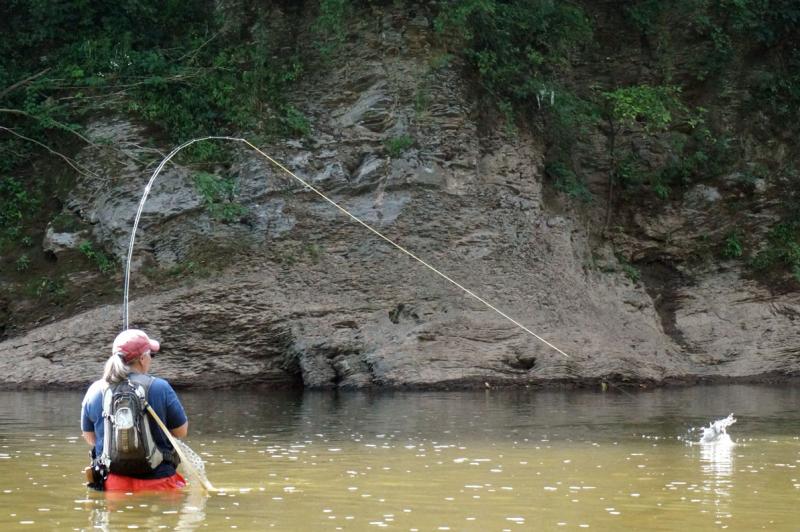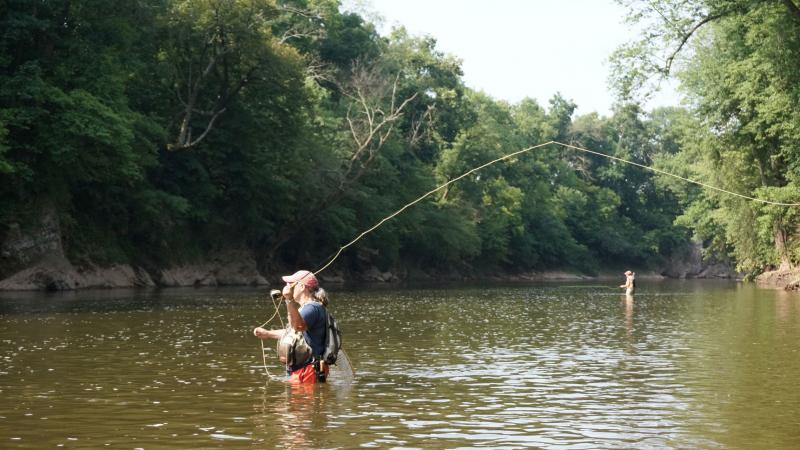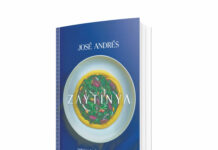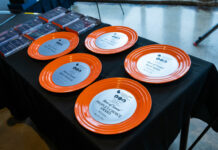We’ve only been on the water for 20 minutes when Kathy Harding hooks a smallmouth bass.
A dozen yards downstream, another angler takes a break from casting to spectate. Farther down the river, a third woman offers a wind-blown “Woohoo!”
This is my first outing with the Chesapeake Women Anglers, a fly-fishing organization that provides a
supportive and noncompetitive environment for women to learn to fish or hone their skills. Currently, the group serves women who span eight generations and all five states of the watershed.
Today, we are trying our luck on a Frederick County section of the Monocacy River, which is mercifully cool on this monstrously hot day.

“You know,” Harding says, as she lowers her net to release the caramel-colored bass, “I don’t even eat fish.”
It doesn’t take long for a newcomer to notice that although these women are serious about fishing, their reasons for being on the river are as diverse as they are. Some like the thrill of pulling in a big one; others
simply enjoy the serenity of standing still in nature.
Harding, who is the group leader this morning, tells me “when you’re out here, you have to think about what you’re doing. You can’t be worried about the bills that need paying or the emails that need answering.”
And every CWA woman I speak with mentions at one point or another that the best part of being a
member of the group is the group itself.
A quarter-century of casting
Carol Stevenson is a founding member of CWA and the group’s president. Stevenson grew up fishing in California but didn’t become serious about the sport until she married a fly-fishing enthusiast.
“I knew I wasn’t just going to sit around on a rock and watch him fish,” Stevenson says, so she jumped in with both waders.
Together, they started a fly-fishing guide service based in Arlington, Virginia. Soon, Stevenson noticed a growing number of women interested in learning how to fish. “We started teaching them, and then they taught others,” she says. “Soon, we were doing trips all over the area and then farther away.” In 1994, this informal collection of lady anglers became the Chesapeake Outdoors Women — “a rather unfortunate acronym,” Stevenson remembers with a chuckle. “So, we changed it pretty quickly to Chesapeake Women Anglers.”
Over the years, the group has hosted events all over the Mid-Atlantic as well as the more storied rivers of the American West. They’ve fished in fresh water and salt water and held skill clinics and fly-tying workshops.
Right now, CWA’s roster is 150 deep, Stevenson reports. “It’s a real steady group of ladies.”
For much of its history, the women of CWA have worked closely with Casting for Recovery, a nationwide program that provides fly-fishing retreats for women with breast cancer. These free weekend outings are equal parts physical therapy and emotional support, where women can get their minds off their illness or find new friends to confide in.Retreat participants in the Mid-Atlantic receive a free year of membership in CWA.
Harding, who has served as a guide for many CFR retreats, struggles for the words to describe these weekends. She finally settles on “very moving and very inspirational.”
A breast cancer survivor herself, Stevenson says that the combination of these two organizations has a special meaning for her. “I never expected to be doing this. But serving these women has become a real focus of my life,” she says.
While CWA has been serving women for a quarter-century, it’s been ahead of the trend. Like most outdoor pastimes, fly-fishing has been a male-dominated world for years. But that’s beginning
to change.
Don’t call it a comeback
A 2018 Recreational Boating and Fishing Foundation Report found that 31 percent of folks on the water are female. And according to The New York Times, women are the fastest-growing demographic in the sport of fly fishing.
To assume women in fly fishing is a new phenomenon is understandable; Stevenson herself calls her group “an underserved community.” However, ladies have been a part of the scene for a long time — since 1496, in fact.
That’s when an angling nun named Dame Juliana Berners is believed to have authored one of the earliest books about fly fishing. In 1892, Mary Orvis Marbury published what is still considered the definitive book of fly patterns.
In the 20th century, British fly-tyer Megan Boyd created some of the world’s most famous flies, including those used by Prince Charles, and Joan Salvato Wulff gained fame as the First Lady of Fly Fishing after she dominated her male opponents in distance casting, contest after contest.
Still, barriers remained. Until recently, fly-fishing gear was almost exclusively made to fit a man’s body. Women who wanted to fish had to put up with cinched waders and traverse currents in boots that were too large. Using the bathroom remained an ever-present conundrum. Concerns about safety kept many women away from the outdoors.
In 2017, fly-fishing retailer Orvis founded the 50/50 On the Water initiative with the ambitious goal of achieving gender parity in the sport by 2020. To accomplish this, Orvis pledged to develop women-specific
gear, provide women-only clinics and engage in women-centric storytelling on its social media and advertising platforms.

For CWA and similar groups, these are welcome changes that reflect a need they’ve been seeing for years.
“If I could find waders, they were bright pink,” Harding says. “That just felt condescending.
Stevenson says that in the last 25 years, attitudes around women in fly fishing have “changed dramatically.
Men have always gone off on these fishing trips with their buddies, and it’s like the ladies all said, ‘You know what, we’re going to do that too!’”
For others, fly fishing has never felt like anything other than a respite from everyday hassles and conflict.
When I ask 89-year-old and longtime CWA member Margaret Chasson what it was like to be a woman on the water when she began fly fishing 60 years ago, she demurs.
“I’ve never felt singled out or unwelcome, but then again, when you’re out there, you’re not looking at anyone else. You’re looking at the fish.”
Test the waters in the Mid-Atlantic
For women with angling aspirations, Baltimore is an ideal home base. The streams of Western Maryland teem with brook trout, while the Bay is rockfish heaven.
Locally, CWA hosts clinics and outings on the Gunpowder River and the Monocacy. After a few hours on the river, we submit to the blazing sun and head back to the parking lot, where the women set up camp chairs and enjoy lunch.
Waders shed and equipment stowed, they share stories, show each other pictures on their phones and exchange small gifts. It’s like any other gathering of women I’ve been a part of, except we’re all wearing damp pants and bug spray. I, for one, am hooked.




